Hellebores for Early Color
 A customer sent me this lovely photo of hellebores she purchased from Carolyn’s Shade Gardens (thanks, Jane).
A customer sent me this lovely photo of hellebores she purchased from Carolyn’s Shade Gardens (thanks, Jane).
This is the third in a series of posts on early-blooming plants, which include Trees and Shrubs for Early Color, click here to read, and Bulbs for Early Color, click here to read. I have revived my blog to provide a few moments of beauty to my readers all over the globe during the worldwide health crisis.
I am dedicating this post to Jeremy and Fran T. at Trader Joe’s and all the brave people who are staffing our grocery stores so we can continue to buy food as COVID-19 keeps us indoors. In the face of their dedication, any sacrifice that we are asked to make seems trivial. Stay home to save lives.
Nursery News: Carolyn’s Shade Gardens is a retail nursery located in Bryn Mawr, PA, specializing in showy, colorful, and unusual plants for shade. The only plants that we ship are snowdrops within the US. For catalogues and announcements of local events, please send your full name, mailing address, and cell number to carolyn@carolynsshadegardens.com and indicate whether you are interested in snowdrops. Click here to get to the home page of our website for catalogues and information about our nursery and to subscribe to our blog.
.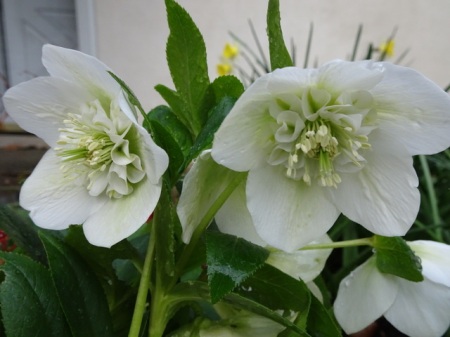 Hybrid hellebores, H. x hybridus, are my favorite hellebores because of their color range and variations in flower forms. Although the inside of the nodding flowers are often difficult to see without flipping them over, each flower is like a gift when I raise it into view. And the back of the flowers are often as pretty as the inside. The photo above shows a rare anemone form with an extra layer of ruffles around the center of the flower. It does not have a name and cannot be purchased. All the anemone form hellebores in our garden were discovered among the hundreds of single-flowered forms we sell each year.
Hybrid hellebores, H. x hybridus, are my favorite hellebores because of their color range and variations in flower forms. Although the inside of the nodding flowers are often difficult to see without flipping them over, each flower is like a gift when I raise it into view. And the back of the flowers are often as pretty as the inside. The photo above shows a rare anemone form with an extra layer of ruffles around the center of the flower. It does not have a name and cannot be purchased. All the anemone form hellebores in our garden were discovered among the hundreds of single-flowered forms we sell each year.
The photos in this post are of hellebores, one of the specialties of Carolyn’s Shade Gardens nursery. Hellebores bloom anytime from January to March, depending on the weather—some even start in the fall. They are easy to grow in well-drained soil in light conditions ranging from almost full sun to almost full shade. Their leaves are evergreen and deer resistant.
.
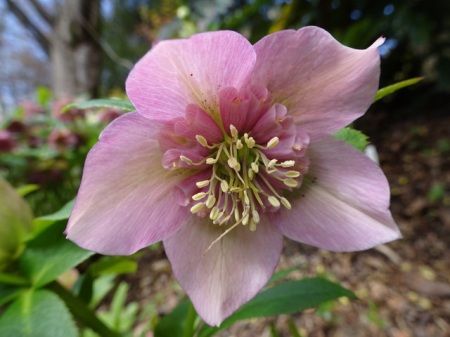 Another anemone form flower. If you want one for yourself, check all the flowers whenever you see hellebores for sale and you may find one. I found this among thousands of singles at one of our wholesale suppliers.
Another anemone form flower. If you want one for yourself, check all the flowers whenever you see hellebores for sale and you may find one. I found this among thousands of singles at one of our wholesale suppliers.
.
Hybrid hellebores or Lenten roses with nodding flowers and plainer green leaves come in a wide range of colors including the highly sought after black, yellow, and orange-tinged cultivars as well as fully double flowers. Many of the hybrid hellebores in our garden are unnamed or no longer available. If known, I am giving cultivar names as well as alternate cultivars that are similar in color and form.
Christmas rose types have desirable outward-facing flowers and often more interesting marbled leaves, but their color range is limited to white, pink, and red and the shades in between, and they do not come in doubles.
.
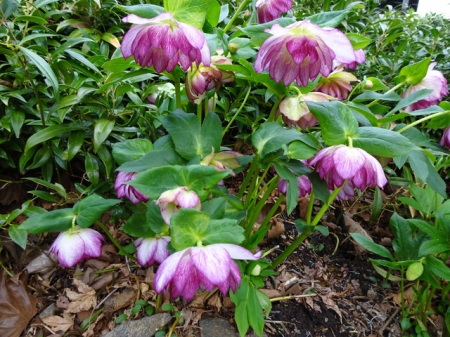 A double-flowered hybrid hellebore called ‘Peppermint Ice’ in the Winter Jewels Series.
A double-flowered hybrid hellebore called ‘Peppermint Ice’ in the Winter Jewels Series.
.
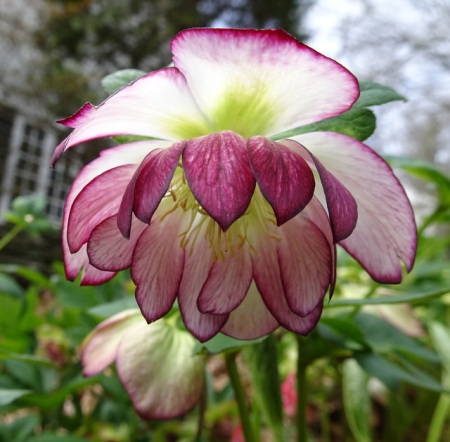 a close up of ‘Peppermint Ice’
a close up of ‘Peppermint Ice’
.
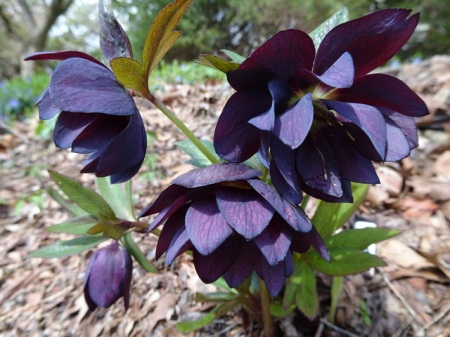 ‘Dark and Handsome’, a double-flowered hellebore in the Wedding Party Series. Dark-flowered hellebores are very striking in the garden but need to be carefully sited so they show up.
‘Dark and Handsome’, a double-flowered hellebore in the Wedding Party Series. Dark-flowered hellebores are very striking in the garden but need to be carefully sited so they show up.
.
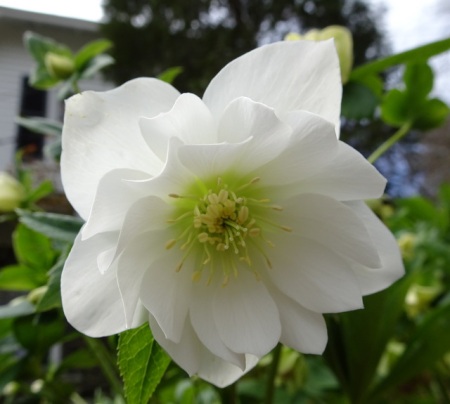 Light-colored hellebores, especially those with white flowers like double-flowered ‘Sparkling Diamond’ in the Winter Jewels Series, stand out in the landscape.
Light-colored hellebores, especially those with white flowers like double-flowered ‘Sparkling Diamond’ in the Winter Jewels Series, stand out in the landscape.
. When hybrid hellebores are happy, they produce dozens of flowers on very large plants. For optimal viewing, site them where you walk in the winter. This unnamed clump is on the hill above the stone wall along our drive, allowing us to look up into the flowers.
When hybrid hellebores are happy, they produce dozens of flowers on very large plants. For optimal viewing, site them where you walk in the winter. This unnamed clump is on the hill above the stone wall along our drive, allowing us to look up into the flowers.
. an old cultivar called ‘Single Black’
an old cultivar called ‘Single Black’
. ‘Cherry Blossom’ in the Winter Jewels Series sometimes has a dark ruffle around the center but can also be fully single or fully double.
‘Cherry Blossom’ in the Winter Jewels Series sometimes has a dark ruffle around the center but can also be fully single or fully double.
.
 ‘Cotton Candy’ in the Winter Jewels Series
‘Cotton Candy’ in the Winter Jewels Series
.
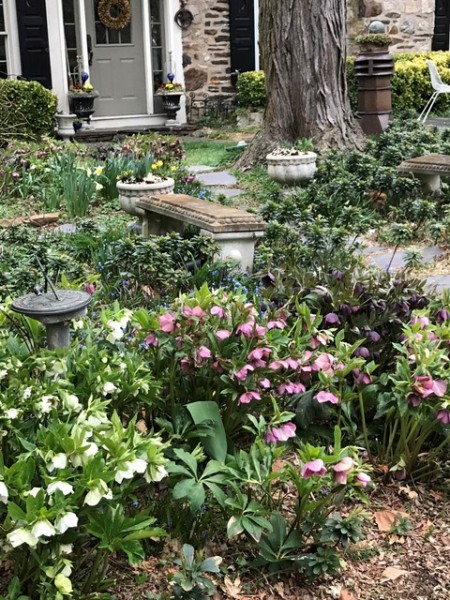 A customer sent me this photo of hybrid hellebores displayed beautifully in her garden (thanks, Mary).
A customer sent me this photo of hybrid hellebores displayed beautifully in her garden (thanks, Mary).
.
 ‘Glenda’s Gloss’ is a Christmas rose-type hellebore and a new addition to the FrostKiss Series. All hellebores in this series are upright with outward-facing flowers and gorgeous marbled leaves. They are the result of a complicated cross including Christmas rose, hybrid hellebores, and H. lividus.
‘Glenda’s Gloss’ is a Christmas rose-type hellebore and a new addition to the FrostKiss Series. All hellebores in this series are upright with outward-facing flowers and gorgeous marbled leaves. They are the result of a complicated cross including Christmas rose, hybrid hellebores, and H. lividus.
.
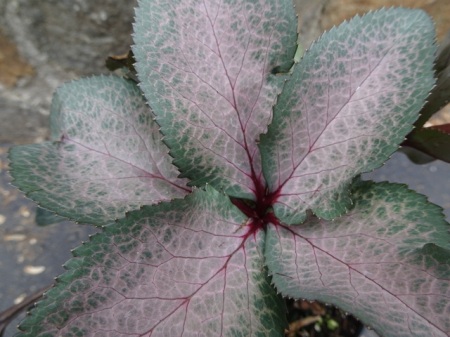 The new leaves of ‘Glenda’s Gloss’ are painted with pink and silver. The leaves of all FrostKiss hellebores gradually fade over the summer to bright green with gold marbling and remain ornamental all winter unlike hybrid hellebores, which can become unsightly.
The new leaves of ‘Glenda’s Gloss’ are painted with pink and silver. The leaves of all FrostKiss hellebores gradually fade over the summer to bright green with gold marbling and remain ornamental all winter unlike hybrid hellebores, which can become unsightly.
‘
 A customer photo of ‘Molly’s White’ purchased recently at Carolyn’s Shade Gardens. It is a very early-blooming member of the Frostkiss series and is almost identical to FrostKiss ‘Moondance’, which blooms a little later (thanks, Martin).
A customer photo of ‘Molly’s White’ purchased recently at Carolyn’s Shade Gardens. It is a very early-blooming member of the Frostkiss series and is almost identical to FrostKiss ‘Moondance’, which blooms a little later (thanks, Martin).
.
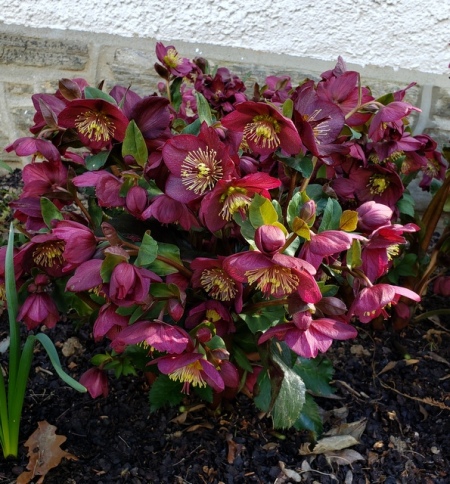 A customer photo of ‘Ice N’ Roses Red’ purchased at Carolyn’s Shade Gardens last spring. The Ice N’ Roses Series results from a complicated cross of Christmas rose and hybrid hellebores plus two other hellebore species, resulting in very robust plants with outward-facing flowers (thanks, John).
A customer photo of ‘Ice N’ Roses Red’ purchased at Carolyn’s Shade Gardens last spring. The Ice N’ Roses Series results from a complicated cross of Christmas rose and hybrid hellebores plus two other hellebore species, resulting in very robust plants with outward-facing flowers (thanks, John).
.
 ‘Shooting Star’ is another product of crosses between hellebore species, this time Christmas rose, Corsican hellebore, and H. lividus. Its delicate pink flowers fading to darker pink face outwards.
‘Shooting Star’ is another product of crosses between hellebore species, this time Christmas rose, Corsican hellebore, and H. lividus. Its delicate pink flowers fading to darker pink face outwards.
.
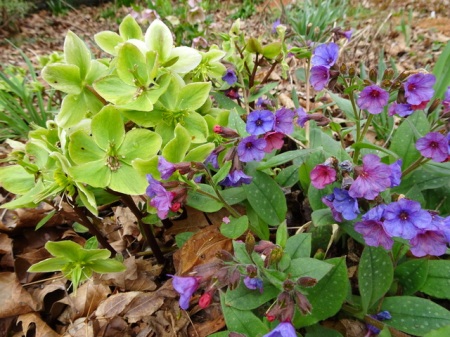 I love green-flowered hellebores. The photo shows pulmonaria with the faded flowers of ‘Honeyhill Joy’, the result of a cross between Christmas rose and Corsican hellebores. Christmas roses, H. niger, have outward-facing, pure white flowers and bloom very early in our garden. They are done now. Although Corsican hellebores, H. argutifolius, are hardy in our area, I don’t consider them a good garden plant as the flowers appear on the end of last year’s ratty leaf stalks.
I love green-flowered hellebores. The photo shows pulmonaria with the faded flowers of ‘Honeyhill Joy’, the result of a cross between Christmas rose and Corsican hellebores. Christmas roses, H. niger, have outward-facing, pure white flowers and bloom very early in our garden. They are done now. Although Corsican hellebores, H. argutifolius, are hardy in our area, I don’t consider them a good garden plant as the flowers appear on the end of last year’s ratty leaf stalks.
.
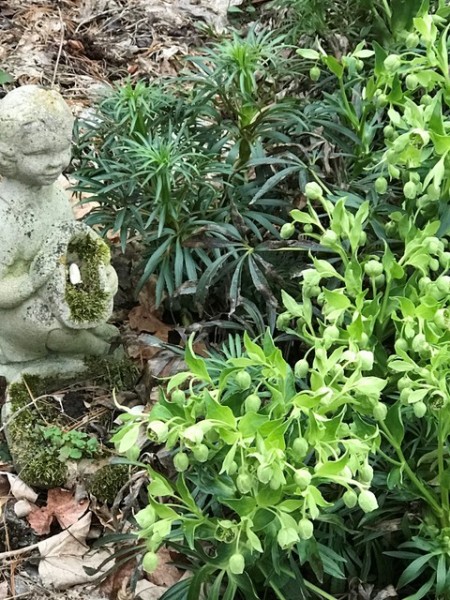 Another customer photo showing bearsfoot hellebore, H. foetidus, in her garden. I love this hellebore species with its clusters of bright chartreuse flowers topping the spidery dark evergreen leaves. The plants can be short-lived but usually reseed themselves before they disappear (thanks, Mary).
Another customer photo showing bearsfoot hellebore, H. foetidus, in her garden. I love this hellebore species with its clusters of bright chartreuse flowers topping the spidery dark evergreen leaves. The plants can be short-lived but usually reseed themselves before they disappear (thanks, Mary).
.
You can provide inspiration to me and other readers by posting comments about your own favorite hellebores. Blogs are a lot more fun for everyone, especially the writer, when they are interactive. Scroll down to the end of the page to the box where it says “Leave a Reply” and start typing—-it’s easy!
Carolyn
Notes: Every word that appears in orange on my blog is a link that you can click for more information. If you want to return to my blog’s homepage to access the sidebar information (catalogues, previous articles, etc.) or to subscribe to my blog, just click here.
April 5, 2020 at 9:42 am
The photo from your customer Mary is just wonderful! Sitting in that garden must be such a pleasure.
What do you do with seedlings that come up so thick? Not sure about pulling vs. transplanting, or some other method. And, ‘Glenda’s Gloss’, both flower and foliage, Wow.
TY for all!
April 5, 2020 at 10:20 am
Great question. The only hellebores that produce seedlings in my garden are hybrid hellebores, and they are a problem because we have hundreds of plants. Christmas rose type hellebores are sterile, which is one of their advantages. However, my customers seem to want the seedlings. I try to deadhead my hybrid hellebores after they bloom and before they produce seeds, which they are doing early this year. Any seedlings that appear are removed. If you want to transplant them, wait until they have true leaves before you move them. But remember that they will not look like the parent.
April 5, 2020 at 12:44 pm
Thank you for posting. Here, downtown in NYC the green is limited, and flowers even more limited. So it is refreshing to see these beautiful spring flowers.
April 5, 2020 at 9:18 pm
Thinking about everyone in NYC constantly. Thank heavens for your heroic governor and major. Keep safe!
April 5, 2020 at 2:20 pm
Really love your blog. It is a welcome respite from being housebound. I’ve learned a lot from you and your readers and certainly appreciate the effort. Thanks, Carolyn.
April 5, 2020 at 9:19 pm
Thanks, Lenore, our gardens are keeping us going right now.
April 5, 2020 at 3:41 pm
The blue type on the black background is illegible.
Change to white? Pale yellow?
Any pale color.
Change your css and it will change your website, not just one page.
Thank you for lovely hellebore pix!
April 5, 2020 at 9:21 pm
The type is light gray so I think the problem must be with your computer. White and yellow are too bright and resulted in a lot of complaints, never had a problem with the gray. Glad you enjoyed the pictures anyway.
April 5, 2020 at 4:29 pm
Oh my, all these hellebores are just so lovely! I was given two plants, no tags or names, some years ago. Since they produce seedlings, I guess that means they’re hybrids? Another one was passed on from someone who didn’t like hellebores (????) for me to rescue from a clump of solid clay soil. So also an unknown! All are single blossoms. The fact that I don’t know their names is of little consequence. All bloomed abundantly this year. Thanks for this nice post; I’m sure I’ll learn lots from you.
April 5, 2020 at 9:22 pm
Many hellebores in my garden do not have names—-I just plant what I like!
April 6, 2020 at 5:30 pm
The more I read about hellebores, the more I want to take better car of ours. They are nothing special, and are not very happy here, but they get ignored too.
April 7, 2020 at 9:45 am
Hellebores require no care here except cutting off last year’s leaves when they get ratty. They are drought resistant and never require watering. I also do not fertilize mine except by mulching with ground leaves. The biggest maintenance nightmare is digging out the hundreds of seedling produced by each hybrid hellebore if I forget to deadhead it before the seeds drop.
April 7, 2020 at 12:10 pm
I had not been removing the foliage. I instead just dumped compost on top of it. I might remove the foliage now that I realize that foliar diseases can overwinter in it, like they do with fallen rose foliage. I do not know if foliar disease is a serious problem, so will watch to see how the discoloring progresses. (The foliage may just discolor as it dies back naturally and prematurely in the arid weather.) When we grew them on the farm, clients actually purchased the feral seedlings that we canned and grew like the rest of the cultivars. Some clients wanted the cultivars, but it seemed to me that the ferals performed better.
April 7, 2020 at 12:40 pm
Hellebores can get foliar diseases, but I recommend removing the old leaves for aesthetic reasons. All hellebores thrive in our gardens whether from seedlings or intentionally planted cultivars. However, the flower colors of seedling plants are never as nice as the cultivars available now, and as we have way too many hellebores in our garden already, I am very picky about quality. Also, I have never gotten a double flower from a seedling as doubles are normally sterile, although a customer just mentioned recently that she has.
April 7, 2020 at 1:18 pm
That is partly why the ferals performed better. The fancier cultivars flopped down as quickly as they bloomed, because the fluffier flowers were too heavy. The single flowers stood up better. Some clients wanted the frillier flowers of the cultivars. Some wanted the single flowered ferals that were easier to maintain and less expensive. The cultivars were certainly not cheap!
April 7, 2020 at 2:27 pm
I have not found that to be the case with double flowers here, which last much longer because they are sterile. Single flowers start going by once they are pollinated. Weight and flopping has also not been an issue maybe because it is pretty cold here when hellebores bloom. We had an early year for hellebores this spring, and the doubles are really the only plants still looking fresh. You are right about the price, but when I pot up my unselected, very large plants, customers don’t buy them no matter how cheap they are. They want the cultivars with better colors.
April 7, 2020 at 8:07 am
Bonjour
Elles sont magnifiques ces hellebores !
The flowers with darks colors are very beautiful….I have never seen such( s ? ) colors….
April 7, 2020 at 9:46 am
Glad you enjoyed the photos. Our good wishes to you and all the French people at this harrowing time.